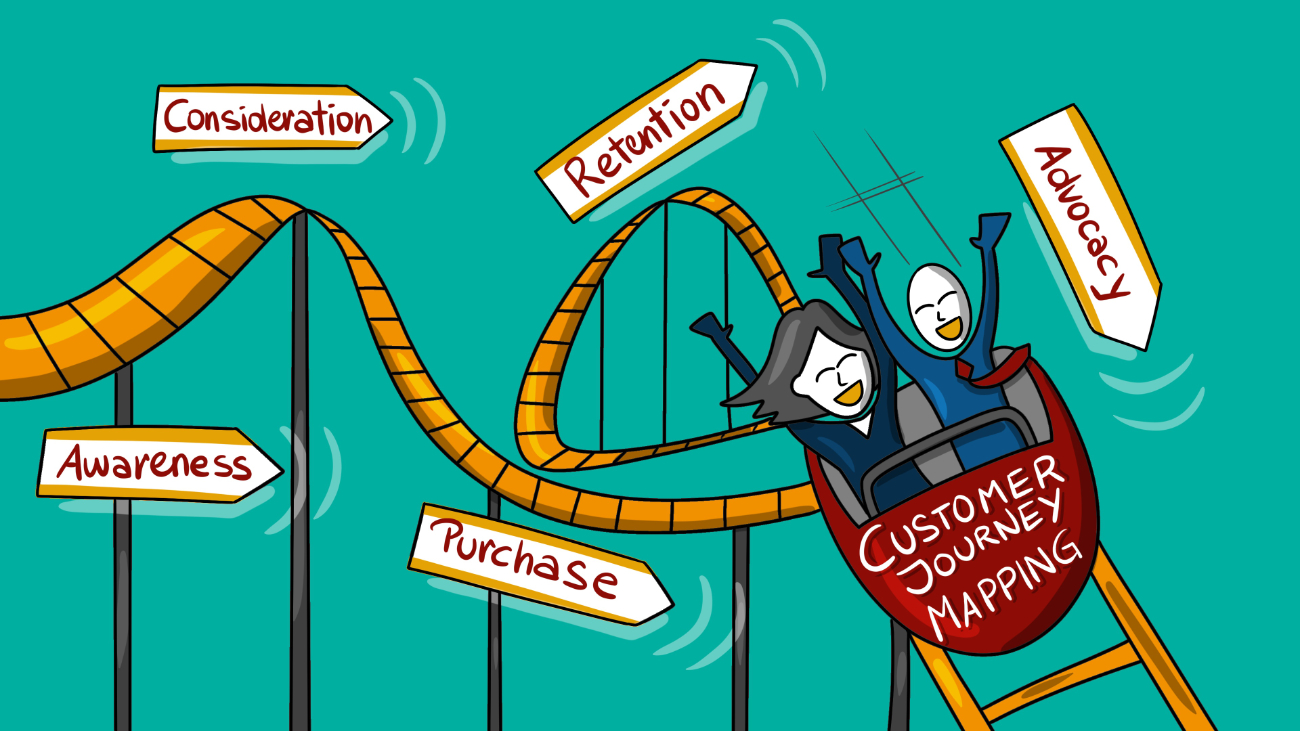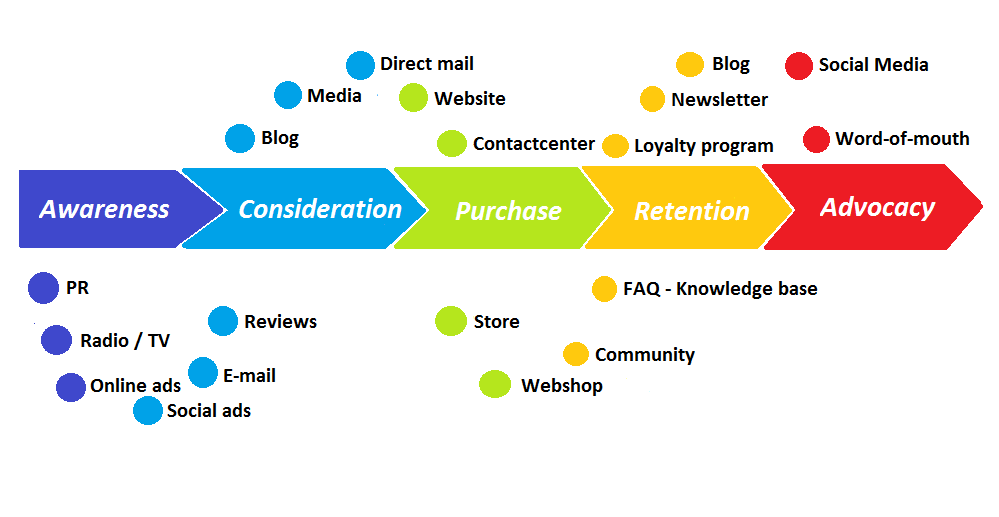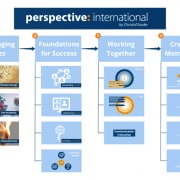Customer Journey Mapping: Create and read maps like they did in the age of the great explorers
Do you have any idea what your customers are thinking about at any given moment… like right now, for example? When did you last contact or have your last “touchpoint” with them? Perhaps you haven’t even noticed that some of your own customers have made a quick detour or are already on their way to your main competitor?

The above questions have absolutely nothing to do with curiosity, but with how you can secure your existing customers and how you can also gain new ones!
That’s nothing new, you say. And you would be right! However, drawing the right conclusions from this is becoming increasingly a game of survival! It’s as if everything is happening in fast motion right now. Hence the notion that business successes and failures go hand in hand.
Your actions will result in concrete consequences if you seriously put your customer first (cf my blog entry on “Customer Centricity“). For your customers are currently moving at lightening speed.
Explanation of terms: The Customer Journey describes the various phases of the customer goes through before, during and after the experience of a product or service (Customer Experience – cf McKinsey & Company). Customer Journey Mapping is a visual depiction of the journey of a customer to all touchpoints. This helps companies to see things from their customers point of view and be able to draw the right conclusions…but more on that later.
 A Visual Representation of the Customer Journey with Touchpoints. Source: Wikimedia Commons, Nick Nijhuis
A Visual Representation of the Customer Journey with Touchpoints. Source: Wikimedia Commons, Nick Nijhuis
Customer Journey:
Typically, there are 5 steps
1. Awareness raising Phase
Coming into contact with the product or service. Initial gathering of information.
2. Consideration Phase
Thoughts become concrete and specific considerations emerge.
3. Purchase Phase
Purchases can take place through various channels e.g. online, offline etc.
4. Post-purchase Phase
This is where first impressions form. Buyers search for confirmation that their purchase was the right one (reduction of post-purchase dissonances) .
5. Becoming a Loyal Customer
Offers and newsletter subscriptions, joining the community.
How long the whole process and the individual phases can take depends on the duration of a product experience and how comprehensive, complex it can be. When dealing with consumer goods (B2C) for daily needs such as food, detergents and cleaning agents or personal hygiene products, the customer journey is more simply structured than when dealing with longer lasting consumer goods such as household appliances or even whole kitchen fittings. At the same time, the amount of personal involvement also plays a role. Take buying a new car, for example, this can be a very emotional affair, especially for men. A considerable amount of time is often spent on it, searching intensively on the internet and making use of respective configurators. In B2B or capital goods sectors, product experiences are once again considerably more extensive than in the B2C-sector where you may be dealing with whole systems.
What does this mean for your marketing and sales?
In order to know and understand the developments and experiences of your customers, it is helpful to:
- Accompany their journey,
- Systematically record it,
- Make it visible,
- Analyze it, and
- Draw the necessary conclusions.
Customer Journey Mapping: Action Steps
It is purely coincidental that the concrete actions for your marketing and sales are also divided into 5 action steps (Such as the 5 Phases of the Customer Journey itself)
Action Step 1: Accompanying the Customer Journey
Watch your customers every move! Keep an eye out for any relevant social media activity such as on Facebook Instagram or other professional platforms such as LinkedIn or Xing. Communicate and interact where your customers are, see what they do and learn about what preoccupies them.
Action Step 2: Systematically record the Customer Journey
Record the data of the Customer Journey of existing and potential customers. The data of existing customers can be obtained through a CRM-System (Customer Relationship Management). The better the data is structured in such a system and the better the processes are integrated, the more automated and data-driven the Customer Journey can be recorded.
Today, product use data is delivered by many hi-tech devices online as well as automatically via the respective interfaces. With the purchase of an electrically powered Tesla car, many consumers will decide, for example, that all details of the utilization of the product are continually recorded and analyzed by the producer. The advantage for the customer lies in an optimal service including appropriate updates. As a provider, you can achieve a special degree of satisfaction and of course customer loyalty. This is also the case for smart home products, IT equipment and software. There are even more advanced systems used in the B2B sector. Remote maintenance is, in the meantime, the rule in plant engineering.
If products are not available via built-in data interfaces, the product user can be motivated to provide their experiences by entering their data manually. This is, of course, much more tedious.
Action Step 3: Making the Customer Journey visible – Customer Journey Mapping
A Customer Journey Map is best presented as a tabular travel report or a logbook and also as a road or mind map. There are no limits regarding the level or way it is depicted.
In the meantime, there are also respective templates for Customer Journey Mapping in interactive whiteboards (e.g. in Miro).
Action Step 4: Analyzing the Customer Journey
Customer Journey Mapping is therefore especially valuable as it helps better understand the customer and their experiences within contexts (Customer Understanding, Customer Insights, Customer Experience). Moreover, this method facilitates the analysis of recurring patterns of thought and behavior (analog routes and stations of the journey) and also influencing factors. This again can help when predicting the continuation of the journey of individual customers and also identifying general trends. The increasing understanding of customers is reflected in an increasingly complete and detailed Customer Journey Map. You can imagine this is the way the great explorers began to map out the Earth hundreds of years ago. After countless journeys, the maps of today are a detailed depiction of reality!
Action Step 5: Drawing the necessary conclusions
Customer Journey Mapping is, however, only helpful when, in the last step, the necessary conclusions are drawn. These are conclusions which optimize your own offer and that is in all marketing mix factors. Developments must be adapted to the ever-changing requirements of customers regarding the product itself, according to the price, marketing and sales and communication.
Customer Journey Mapping: Conclusion & Summary
In conclusion it should be noted: All the above-mentioned points (steps) are not fundamentally new, but they describe the marketing basics, familiar to us for more than 60 years. What is new, however, is the speed in which changes occur and these are not continuing developments but sudden disruptions! The Concept of the Customer Journey and the Methods of Customer Journey Mapping are particularly suitable for recognizing the disruptions at the earliest possible moment and successfully managing them. A fully automized, data-driven Customer Journey Mapping which includes appropriate proposals for action is still a future dream. Nevertheless, Google & Co. are working exactly on this development at top speed and beginning to perfect it.
Data is, after all, required and intelligent CRM-systems are needed for it. The future has finally also begun for mid-sized and smaller companies which do not yet have access to a comprehensive data base.
Customer Journey Mapping is therefore mainly a question of mindset!
Everything starts thinking outside the box, establishing the process of the Customer Journey Mapping in your business and then developing it.
In the numerous webinars and online workshops I have had the pleasure of attending in the last months, the Customer Journey has constantly played a role and was of great interest to all participants. If you would like to find out more about areas of Customer Journey, Customer Journey Mapping, Remote Selling and Hybrid Selling, simply click on the following link: Workshops & Services

He founded perspective: international in 2013. He works as a strategic advisor, operative facilitator and interim manager with many years of experience in internationalization and international business development.



